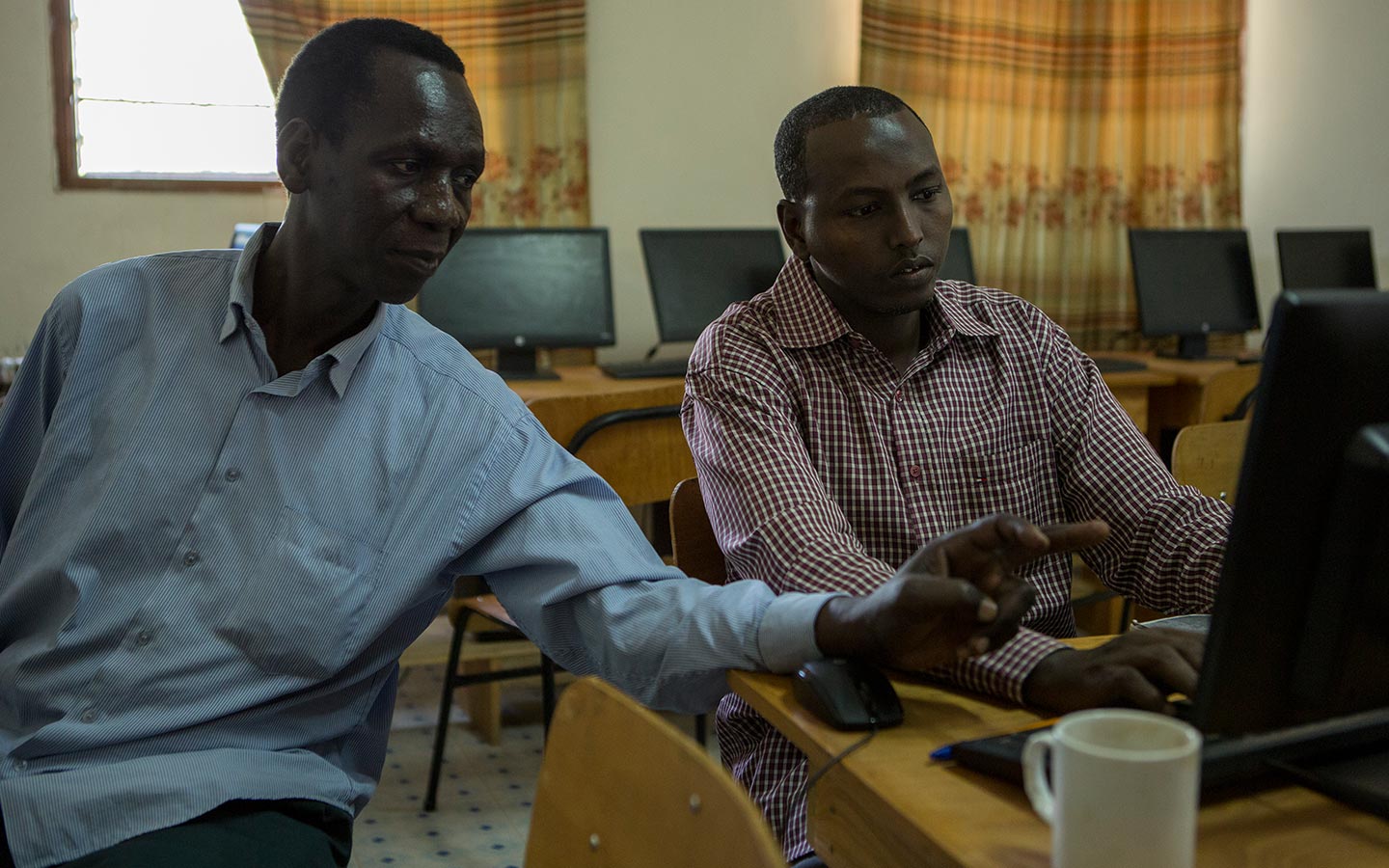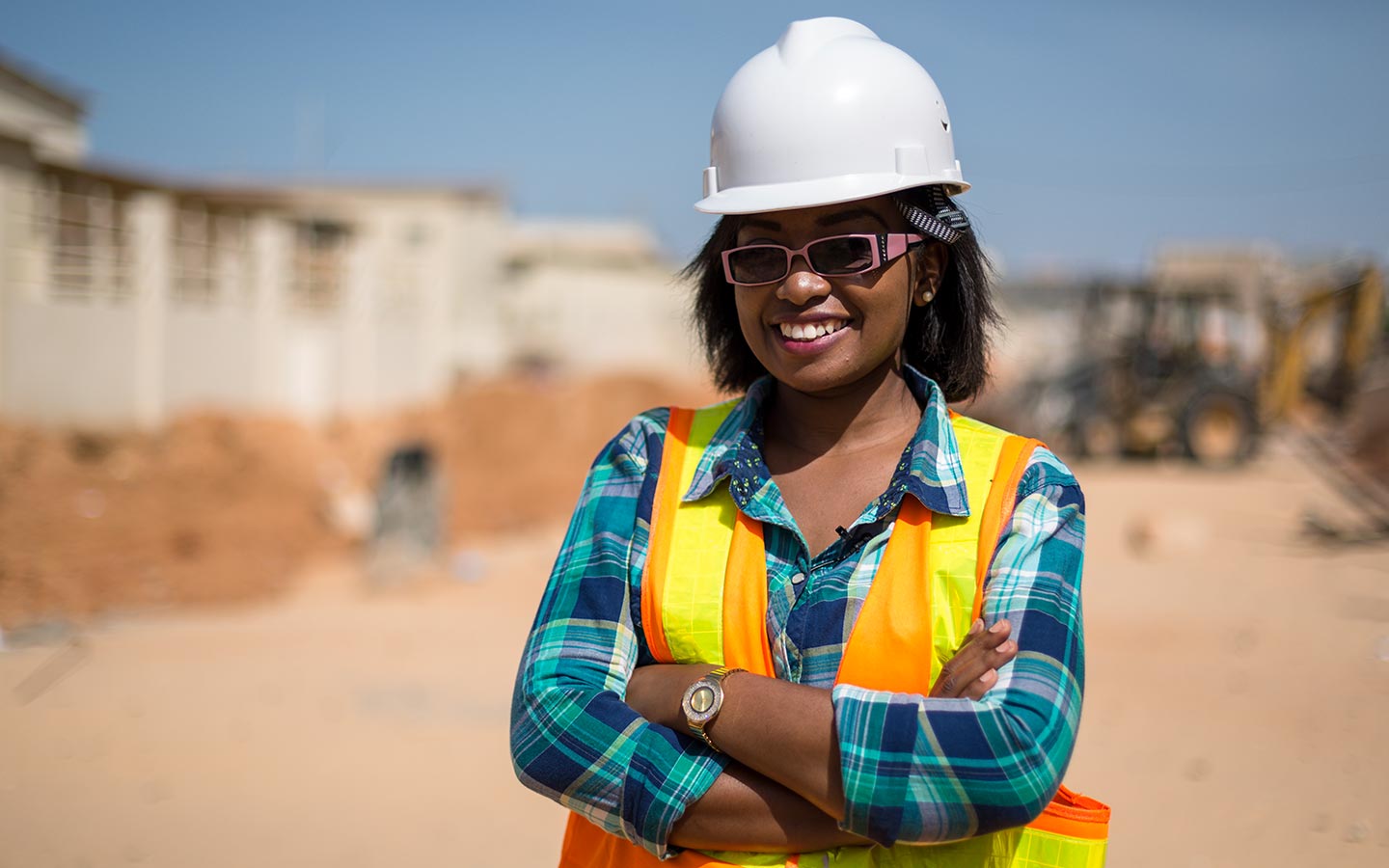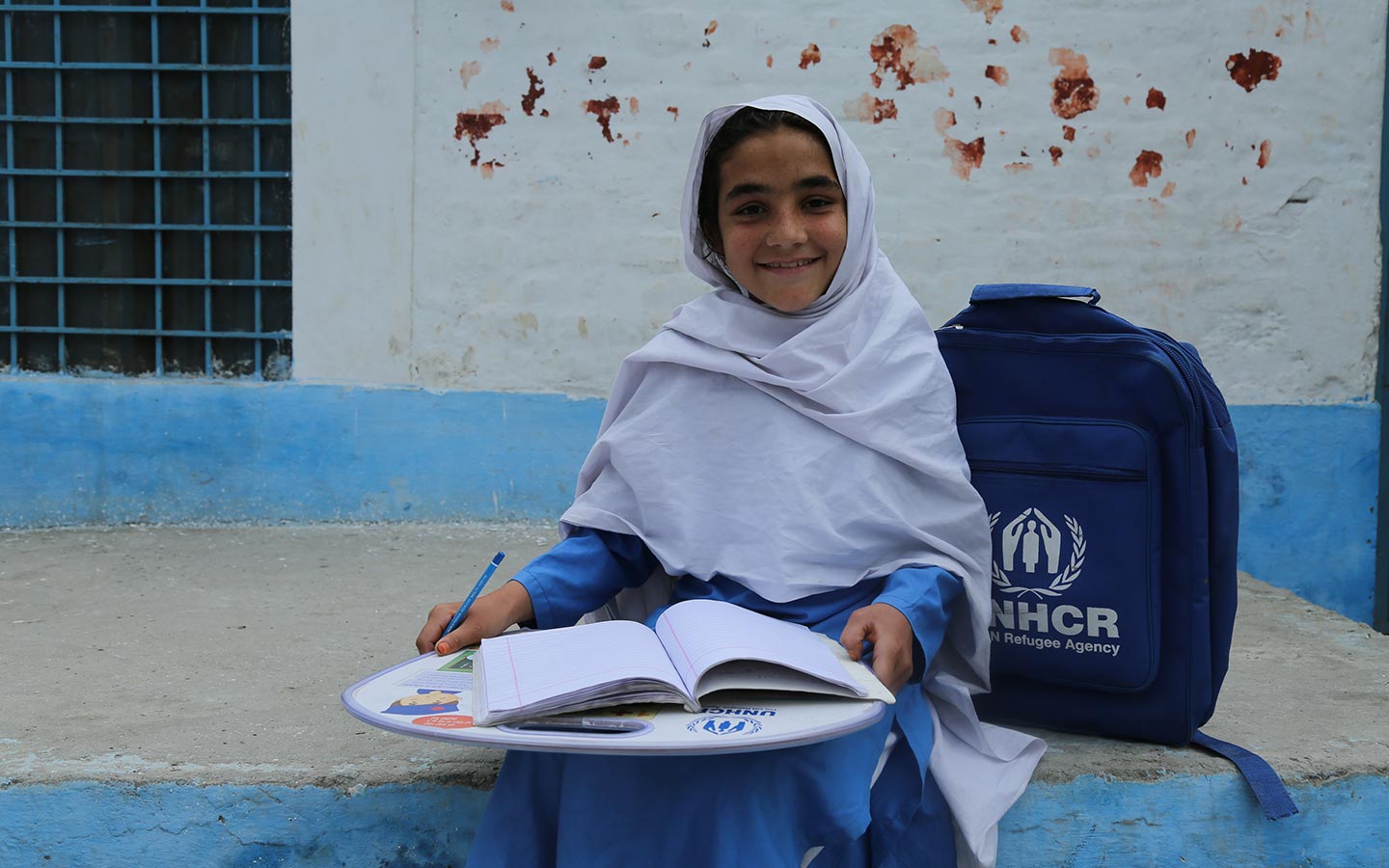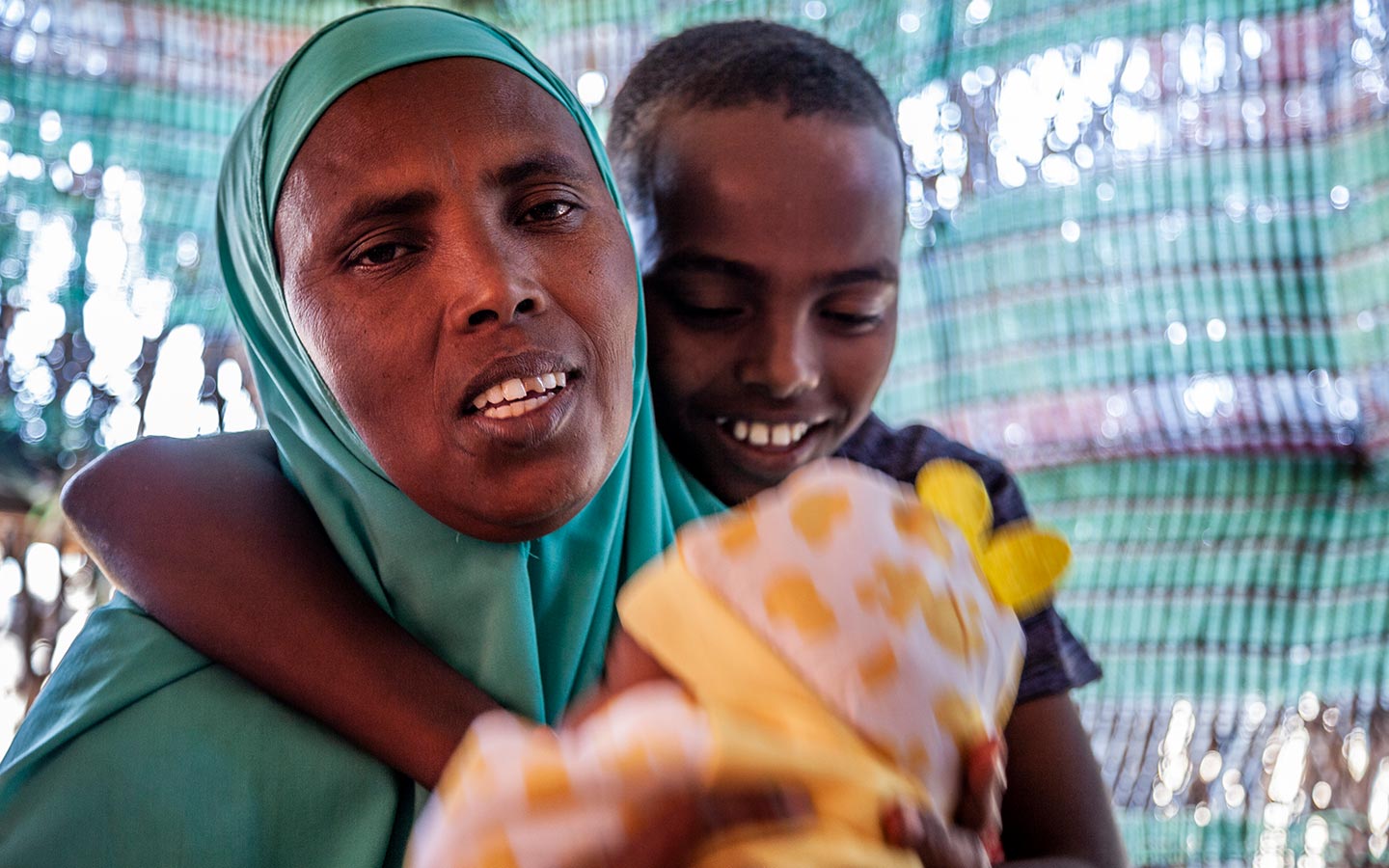CHAPTER 3:
It’s everyone’s business to educate refugees
Emerance (left), 16, Burundian refugee, is the captain of an all-girl football team in Lusenda camp in the Democratic Republic of the Congo. UNHCR, in partnership with Radio France Internationale, provides equipment for refugee players. ©UNHCR/Colin Delfosse
Decades of experience have taught UNHCR that the most effective way to ensure that refugee children go to school and stay there is to include them in the local school system. This requires national and local support and collaboration. When a refugee child enters a local school, it is often a first step in the community to welcoming them into their midst.
Partnerships, both local and international, are key to UNHCR’s mission to break down the barriers to education for millions of refugee children. UNHCR is one of a large community of organizations seeking to uphold the rights of refugees and the internally displaced, and only one of the many who support and protect children at risk. Despite these efforts, the number of refugees who are out of school continues to increase at an alarming rate, highlighting the need for new solutions and additional partners to join this challenge.
Investment in primary education has brought about an expansion of educational opportunity. But it has also created a need and a demand for secondary and higher education – a demand that is going unmet. The further refugees progress in their educational journey, the harder it is for them to stay in school. The priority now must be to enable refugees to pursue and complete their education, from the first day in primary school all the way to receiving their diploma.

©UNHCR/Antoine Tardy
Okello Mark Oyat was 25 when he arrived in Dadaab refugee camp in Kenya as a refugee from Uganda. Three decades later, he graduated with a bachelor’s degree in social studies from York University, Canada, through the Borderless Higher Education for Refugees distance learning programme. Today, he has secured a scholarship for a master’s programme at York and is helping other refugees apply to online education programmes.
A swift and rapid expansion of schools and flexible education opportunities is required, whether in refugee camps or in urban and rural environments. Contrary to popular misconceptions of who refugees are and where they live, only 30 per cent of them reside in camps; the majority are to be found in villages, towns and cities, in private homes or in unofficial settlements. Supporting educational facilities in those environments not only benefits a large number of refugees, but it also serves local populations in countries where the educational infrastructure is already overstretched – making long-lasting differences for host communities and boosting relations with refugees.
If the arrival of refugees means durable gains through more schools and more teachers, their presence becomes an advantage, not a drain on resources. Yet the sheer number of refugees in some countries presents challenges that go well beyond the capacity of the host government. It requires the mobilization of the private sector, in concert with the international community and established humanitarian and development actors, to ensure that both refugees and their host communities have a sustainable and resilient future.

©UNHCR/Antoine Tardy
“Education is the foundation of everything and preserves your dignity.”
Yvonne Meritina Umutesi, 28, fled from Rwanda to Senegal as a young girl. A DAFI scholarship enabled her to complete a degree in Health, Safety and Environment and she is now a manager at a private construction company in Dakar.
The whole-of-society approach of the New York Declaration and the global compact on refugees paves the way forward. In the East and Horn of Africa, eight countries came together to sign the Djibouti Declaration in December 2017, committing to include all refugee and returnee children and youth in national education plans by 2020, to improve education quality and to expand training opportunities. In support of these important efforts by host countries, the international community, including humanitarian actors, development actors and the private sector, must engage to ensure that refugees and the communities hosting them have a sustainable and resilient future.
UNHCR’s partnership with Educate A Child (EAC), a global programme of the Education Above All Foundation (EAA), brings together organizations as disparate as UNESCO, Qatar Airways, and the Dutch and Swedish Postcode Lotteries to help children, including refugees, by building and renovating schools, recruiting and training teachers, providing learning materials, supplying uniforms and pursuing other measures to eliminate the barriers they face to getting an education of good quality. The number of formerly out-of-school refugee children enrolled in primary school through EAC surpassed one million with the start of a new school year in August 2018. Without this programme, the enrolment rate of refugee children in primary school would have plummeted, derailing the hopes and prospects of a generation of children. Thanks to EAC support, primary school enrolment increased by 160 per cent in supported schools in South Sudan between 2015 and 2017. In the same period, it grew by 109 per cent in Kakuma, Kenya; by 80 per cent in Kenya’s Dadaab camps; by 56 per cent in Rwanda; and by 43 per cent in Malaysia.
CASE STUDY
Tale of two sisters
Ethiopian girl becomes one in a million – but her elder sister is forced to make sacrifices
Rihanna Siraj, 15, Ethiopian refugee, attends school in Kakuma refugee camp, Kenya. She is among one million formerly out-of-school refugee students who now go to primary school thanks to the support of the Educate A Child programme. ©UNHCR/Anthony Karumba
Rihanna Siraj looks up from her desk to follow what her teacher is writing on the blackboard. She is a picture of concentration, whispering a few lines under her breath before writing in her exercise book. There are many students in her sweltering classroom: Rihanna is fortunate enough to sit at the front so she can hear her teacher better. This is a science class – Rihanna’s favourite subject. “I like science because I want to be a doctor,” she says.
Rihanna, 15, an Ethiopian refugee, is one of the many thousands of students in Kakuma refugee camp, in northern Kenya. When she was nine, she and her younger sister, Ikra, were separated from their parents during their family’s journey to escape violence and persecution at home. Kakuma was where they started a new life, looked after by their elder sister, Fauzia, who arrived there a year before them. The girls have no idea if their parents are still alive.
Rihanna is literally one in a million out-of-school refugee children around the world who have been enrolled in primary school, despite being overage, thanks to Educate A Child (EAC) – a global programme of the Education Above All Foundation that unites private sector actors, foundations, non-governmental organizations and UN agencies to ensure out of school children get the opportunity to go to primary school. The programme helps with teacher training, school infrastructure and equipment, innovative ways to make sure children can attend school, and the provision of teaching and learning materials.
Kenya: Tale of two sisters
Today, more than 80,000 refugee children are enrolled in school in Kakuma refugee camp. But if Rihanna’s medical ambitions show what a young refugee can aspire to if given the chance, Fauzia represents the tens of thousands who are not so lucky.
Fauzia tried her best to stay in school. She started making potato chips to earn some money for herself and her siblings, cooking in the morning before school and during her lunch break. But by the fifth grade she had dropped out. “I could not study because I had to come home and find work to care for my sisters,” Fauzia says. “The cooking job and school could not go together. So now I work and they study.”
“My sister works in the market – she takes care of us like that,” says Rihanna. Fauzia now cooks for a restaurant but tops up her income with occasional work in a grocery store. “It is hard but she doesn’t have any choice.”
Fauzia is determined to see her sisters get an education. “If they go to school, tomorrow they can help me or their own families. There are many things they can do with an education.”
Rihanna appreciates her sister’s sacrifice – all the more so because school offers her protection against many of the cultural expectations girls face: early marriage, motherhood and a life where looking after the home and caring for younger family members may come ahead of going to school. “I feel like my sister protects me from those issues because some girls are getting married earlier,” she says.
And she promises to make Fauzia proud.
“When she sees us go to school, she feels like she is going to school.”
Strong partnerships have shown how companies can combine their expertise for the sake of the refugee community. It would be rare to find the likes of Gucci, Microsoft and Western Union pulling in the same direction, but the Global Business Coalition for Education has made it happen – bringing together business, civil society, educational experts and senior policymakers to facilitate joint projects where each party brings its own set of skills, assets and experiences.
Even if there are no school fees to pay, the cost of uniforms, books and supplies often presents an insurmountable barrier that keeps children from school. Since 2015, UNHCR’s partnership with the H&M Foundation, a non-profit organization funded by the founders and owners of the global fashion company H&M, has enabled an estimated 500,000 children at primary and lower-secondary levels to benefit from textbooks, stationery, uniforms and lap desks in 12 countries across Africa, Asia and the Middle East.

©UNHCR/A. Shahzad
“I want to be a teacher when I grow up.”
Shihnaz, 8, Afghan refugee, attends primary school in Khazana refugee village in Peshawar, Pakistan. The lap desk she received from H&M Foundation, as part of the Educate A Child programme, makes up for a lack of desks in a crowded classroom.
The transformation of Dollo Ado
Educating a child takes a lot more than simply building schools. In 2012, in the Dollo Ado region of Ethiopia, close to the Somali border, UNHCR launched an ambitious programme to improve the lives of everyone living there, from the host community to every refugee man, woman and child who had fled there. Education was central to this strategy. At the time, the education system was in a sorry state, with just 18 per cent of children in school.
This was made possible by a first-of-its-kind, multi-year partnership with the IKEA Foundation. Funding from the IKEA Foundation enabled UNHCR to start microfinance schemes for refugees. An irrigation project meant barren land was now farmed by refugees and the host community. As their incomes increased, parents were less likely to withdraw their children from school to work as manual labourers. Meanwhile, a project to bring electricity to the region had multiple benefits. Streets were lit. Hospitals and health centres had refrigeration for medicines. And computers and tablets helped teachers to improve the quality of the learning environment with digital lessons and more engaging ways of teaching.

©UNHCR/Diana Diaz
“I am very proud of her for being so strong and supporting me all my life.”
Bishar Yusuf (right), 14, Somali refugee, is proud of his mother, Axada Muhamed Muhumed (left), for earning money at the local market that enables him and his siblings to go to school in Melkadida refugee camp, Ethiopia. The IKEA Foundation has increased access to education and livelihoods for refugees throughout the Dollo Ado region of Ethiopia.
Meanwhile, investment in primary education means that the number of classrooms has quadrupled to over 400, with many functioning on double shifts. As a result, by the end of the 2017 school year, over 47,000 refugee children were in school. This is more than twice as many as in 2012.
Enrolment in secondary school remains challenging, with enrolment at just six per cent. In the coming school year, as the majority of grade eight children have passed their exams, the 32 secondary classrooms available will be packed to bursting with over 70 students per class. This is well above the global recommendation of 40 students. Sixteen new classrooms are needed, but funding is elusive.
Space is not the only challenge. As more children succeed in completing primary school, there are not enough qualified teachers for the secondary school. A teacher training college in Dollo Ado opened its doors to students in early 2018, with the first graduates expected in 2020. Over 200 Ethiopian students and 23 refugee students are part of the first cohort of student teachers.
Poverty remains the greatest barrier to education for this population of Somali refugees, and for most refugees around the world. In the past couple of years, successive cuts to food assistance have been accompanied by increased absenteeism and dropouts from school as refugee children have had to go to work to help the family finances.
CASE STUDY
‘The key to the world’
Teacher training college aims to answer huge demand from young learners
Yusuf Isak Ibrahim, 26, Somali refugee, raises his hand at the Teacher Training College in Dollo Ado, Ethiopia. He is studying there to become an English teacher. ©UNHCR/Diana Diaz
When Yusuf Isak Ibrahim and his family fled the fighting in Somalia in 2011, finding safety over the border in the Dollo Ado refugee camps, the idea of getting an education looked like a remote possibility.
Like many youngsters in Somalia, Yusuf hadn’t been allowed to go to school as a teenager. “There was a war and Al-Shabaab [the extremist Islamist movement] was present. They said no one should go to school, no one should teach. They decided everything in our lives,” he says.
At Dollo Ado, his chances did not look much better. When he arrived, there were two primary schools, one secondary school and a grand total of 240 teachers for almost 100,000 young refugees like himself.
Now aged 26, Yusuf is one of 265 young adults learning to become teachers at Dollo Ado’s Teacher Training College. If you had told him a decade ago this is what he would be doing, he says, his teenage self would never have believed it.
“I once heard that teachers are the key to the world. This is why since I was young I always wanted to become a teacher.”
Ethiopia: Teacher training school unlocks hope for Somali refugee teachers
In Dollo Ado, there are currently 70 schools and learning centres with over 750 teachers. The Ethiopian government has committed to integrating refugees in its national education system, as well as expanding tertiary education opportunities. Yusuf has benefited from both ambitions.
Today, 53 per cent of refugee children in the area are enrolled in school – still not close to enough, but a significant improvement compared to a few years ago.
By ensuring a constant supply line of teachers, the new training college, set up with the financial support of the IKEA Foundation, could change the game completely.
The college is the only one of its kind within a 500 kilometre radius. It opened its doors in November 2017 to train both refugees and members of the local community who wanted to make a difference in the lives of children in Dollo Ado and the surrounding areas.
“Refugees [flee] their countries without anything and here they have the possibility to change their lives, to be employed, to get an education,” says Fadumo Osman Nour, a 19-year-old Ethiopian and one of Yusuf’s classmates.
“And most importantly, by learning together we can all contribute to our communities. Education is the key to life, and I believe all of us can be integrated through education.”
In a couple of years, Yusuf, who is studying to become an English teacher, will be among the college’s first cohort of graduates. Initially they will work in schools in the refugee camps but if they get the necessary work permits they hope to fan out and teach across this densely populated region.
“If you are educated you can sort out your life, you can get a job and provide for your family,” Yusuf says. “And this matters for everyone, men and women.”






